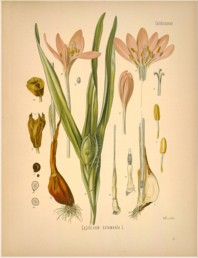Curious Colchicum
By Audrey Stallsmith

Or those pure chalices that Kentish men
Call Naked Boys, but by a lovelier name
Others call Naked Ladies, slender, bare,
Dressed only in their amethystine flame,
The Meadow Saffron magically sprung
By dawn in morning orchards in the grass
Near paths where shepherds on their errand pass
But ender-night beheld no crocus-colour there.
"The Garden" by Vita Sackville-West
A crocus that blooms in the autumn has to be considered curious. But one that produces flowers without leaves in September or October, and then leaves without flowers in June or July, might be called downright weird.
Add to this the fact that colchicine--a toxin derived from colchicum--inhibits the division of cells and has been used to produce plant mutations. And you take strange to a whole new level!
But then we might conclude that this imposter isn't really what it appears to be. Colchicum belongs to the lily family, while other crocuses adhere to the iris clan. And it has six stamens instead of the common three. Not to mention that colchicum produces leaves up to a foot long, and a mature corm the size of a small apricot. Obviously not crocus-like.
The flower is named for the land called Colchis, from which mythological Jason supposedly stole a golden fleece--a country once located in parts of present-day Georgia and Turkey. Colchicum has also been known as ephemeron, hermodactyl, surugen, and herbstzeitlose. (Though there were actually two plants dubbed ephemeron, the other being a wild iris.)
Besides "naked boys" or "naked ladies,"--an allusion to the lack of leaves when the flowers bloom--colchicum's nicknames have included "meadow saffron," "wild saffron," and "son before the father." Aside from the fact that both bloom in the fall, there is actually little resemblance between genuine saffron and colchicum, especially considering that the latter is quite poisonous.
But it has been used in small amounts to treat both dropsy and gout. In the 1950's, Edward Hartung reported that the drug was usually "given by mouth in tablet form. . .at the onset of a gouty attack, and then every hour. . .until diarrhea is induced." (This might be one of those cases where the cure is almost as bad as the disease.)
Scientists once had hopes that colchicine could be used to cure cancer as well. But that was before they discovered the effective dose to be a lethal one--which rather defeats the purpose!
Although it is a slow-acting poison, colchicine depresses both the heart and the nervous system and can eventually cause respiratory paralysis. Doctors in Slovenia reported a 2003 case where the patient mistook the plant for wild garlic. He did die, but he also had liver problems which may have contributed to his demise. Most deaths attributed to colchicine have been from suicides taking overdoses of gout medicine.
The ancients recommended cow's milk as an antidote to the poison. Colchicine can also be found in gloriosa lilies--the tropical vines, not the rudbeckias that go by the same name!
In the Language of Flowers, colchicum stands for "My best days are past." But fall-blooming flowers always imply to me that best days can come quite late in the year. So we should never assume that we've seen the last of them!
Image is from Köhler's Medizinal-Pflanzen, courtesy of the Missouri Botanical Garden Library.








